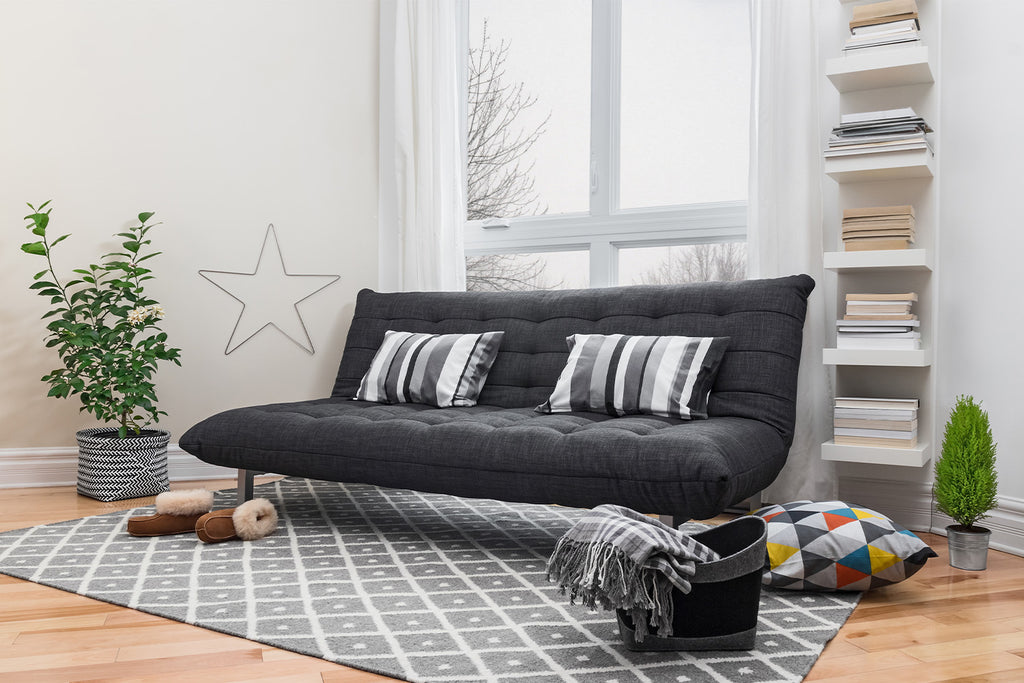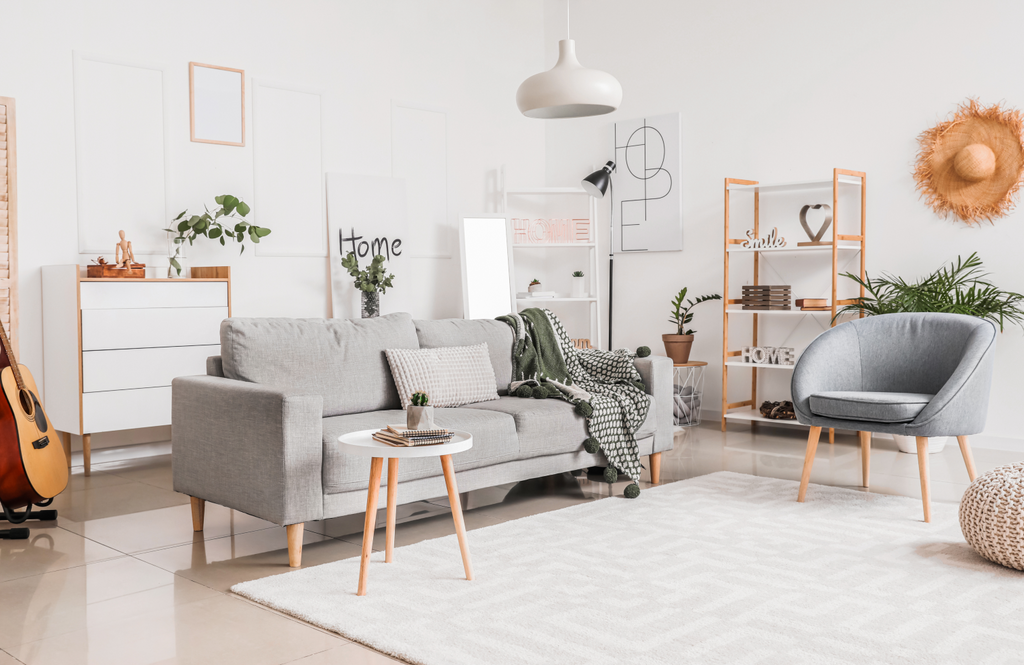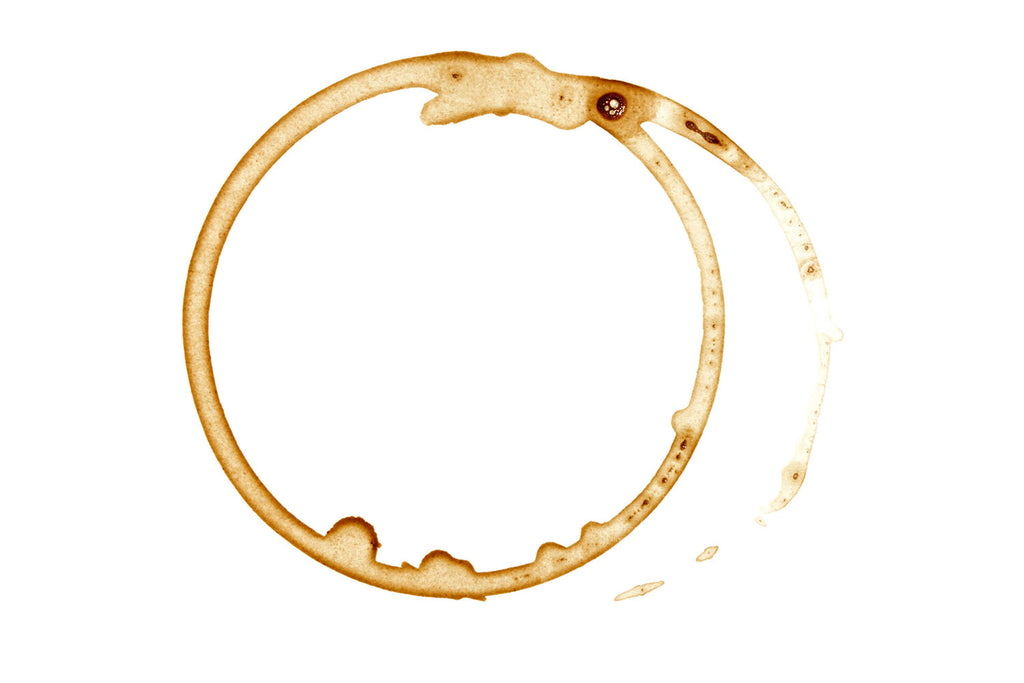
What Size Bed Does a Futon Make?

We all know and love the futon. Maybe you had one in your college dorm room that you would use to relax, play video games, or host guests. Maybe you have one in your home office that doubles as a guest room.
It’s an incredibly useful piece of furniture that’s charming, multifunctional, and kind of genius. But if you’re going to be using it for sleeping, it’s important to know what size of bed you’re going to get.
So today, we’re going to break down everything you need to know about a futon. From what size it is to how to best use it, by the end of this article, you’re going to be a certified futon expert.
Let’s get started.
What Is a Futon?
When you think of a futon, your mind most likely goes to a pretty particular image from your past. In all likelihood, you think of a particularly shaped couch, one with no arms and a sleek design. The back folds down to turn into a bed and can be locked in an upright position to serve as a couch.
It’s a unique, multifunctional piece of furniture that is incredibly useful for pretty much any home, especially if you live in a small space where a room or area needs to serve multiple purposes.
Why Are Futons so Popular?
Futons have become so popular in the last couple of decades because they are so practical. When it comes to modern design, multifunctionality is one of the most prized qualities of any piece of furniture. There’s a good reason the history of the futon dates back thousands of years.
Futons can turn any room into a guest room with ease. Your office, your living room, and even your bedroom can gain the ability to sleep another person or two. They make sleepovers easier, and they’re a fun and exciting addition to the room.
Where Did Futons Come From?
Futons have evolved a lot over the years. In fact, if you saw what the first futon looked like, you probably wouldn’t recognize it as a futon at all.
Futons originated in Japan, and, in their traditional sense, they are a takeaway bed. Japan is a very densely populated place. Big cities and even rural communities don’t tend to have many large houses with big open spaces and lots of bedrooms.
Because of the small spaces, rooms often have to function as multiple things, and futons were a way to add sleeping arrangements to a room. But the Japanese don’t have a bunch of futon couches in their rooms. Instead, futons in Japan are more like takeaway beds.
They are typically somewhat thin cotton mattresses that are placed on top of a softer floor called a tatami mat. The mattress is made in such a way that allows you to fold it up easily and put it away when you’re not using it.
Sleeping on the Floor
People in Japan have slept on the floor for centuries, and takeaway futon beds are still one of the most popular bed styles in Japan. But before the modern cotton futon mattresses came around, the Japanese slept on various other types of mats on the floor.
Centuries ago, before cotton was readily available in Japan, their sleeping mats were made of straw or sturdy, woven grass. Nobles would sleep on tatami mats that were a bit softer and more comfortable for sleeping. Traditional Japanese homes still have tatami mats lining the floors.
But now, the mats are much thicker and are made of cotton. You might know them by another name: Shiki futons or Shikibutons. They’re filled with comfortable padding to make the sleeper a bit more comfortable, but the benefits of sleeping on the floor are still there.
Sleeping on the floor provides a harder surface, which can feel amazing for your back. Back sleepers tend to love them, as they help to align your back as you sleep throughout the night.
Western Futons
In the West, futons were practically unheard of until the middle of the 20th century. After American soldiers returned from World War II efforts in Japan, many of them told amazing tales about the unique Japanese floor mattresses and the wonders they worked on their backs.
At that point, futons began to gain some popularity in the States and beyond. But many people in the West didn’t much like the idea of sleeping on the floor. There are stigmas against floor sleeping in the West that simply don’t exist in the East.
So Americans started to create platform beds. This essentially provided an elevated sleeping surface for a futon mattress to be placed on.
This idea has influenced modern furniture design quite a bit. Platform beds are now quite commonplace in Western interior design. And many bed frames are much closer to the ground instead of being high up.
The big rise in futon popularity didn’t come along until the end of the 20th century when the futon chair was first introduced. This unique design created a bed frame that could fold up into a comfortable chair, mattress, and all. It was a great multifunctional piece of furniture that appealed more to Westerners than traditional futon mattresses.
From there, the designs changed and adapted. Eventually, manufacturers started creating furniture with the “mattress” built right into the upholstery. Today, we have the futon couch that we all know and love.
Different Futon Designs
There are a lot of different types of modern futons. The most popular futon style looks like your standard, run-of-the-mill couch. But the back folds down to lie flat, providing a larger, flat sleeping surface.
But there are other styles as well. Some futons look like sectionals normally. But a hidden compartment under the couch can be pulled out and raised up to provide one flat sleeping surface.
Of course, you have the couch bed, which is a major adaptation from the futon. Take off the couch cushions and reveal a complicated piece of machinery that magically folds out of the base of the couch to provide a large sleeping surface with a mattress.
How Big Are Futons?
Now, let’s get to the reason you clicked on this article: the size of a futon bed. Before you make the purchase, it’s important to know how big of a sleeping surface you’re going to get so you can decide whether or not it can fit your needs.
How Big Is a Standard Futon?
Most futons, especially ones where the back of the couch folds down to make a flat surface, are going to create a sleeping surface that is about the same size as a full-size mattress.
Full-size mattresses are 54 inches wide and 75 inches long. It’s bigger than a twin bed but smaller than a queen bed. This means that one person can sleep there quite comfortably, but if you wanted two people to sleep there, things might get a little crowded.
It is still very possible to sleep two people on a futon, but you should know that most couples opt for a queen or king-size mattress.
Are There Exceptions?
Of course, there are exceptions to this rule. If you look hard enough, you can definitely find twin-size futons out there. You can even find queen-size ones if you look hard enough.
But for a futon, the full-size really is the best of both worlds. It’s big enough for one or even two sleepers, but it’s small enough so that it doesn’t take up a ton of space in the room when it’s not in use.
The purpose of a futon is multifunctionality, so the size of the futon during the day makes a world of difference. That’s why most people prefer the full-size futon.
What Size Is the Japanese Futon?
In Japan, most futons are about the size of a twin bed and are meant for single sleepers. The Japanese futon is meant to fit directly on top of a tatami mat, about three feet wide and six feet long, so those futon mattresses are about that size.
How To Use a Futon
Now that you know what you need to know about the size of your futon, let’s talk about how you can use your futon once you’ve brought it into your home.
During the Day
One of the main purposes of the futon is to be used as a couch during the day. Futons are quite popular for home offices or other spare rooms that need to act as a guest room in a pinch. But during the day, they can be used for lounging during a break.
You might also have a futon in your living room, in which case it can be used for watching TV, hosting party guests, and anything else that you do in your living room.
How To Sleep on a Futon
Now for the real nitty gritty: how to sleep on a futon. To get the best sleeping experience out of your futon, we’ve come up with some tips and tricks you can use to make it comfortable for a long, restful night of sleep.
You’re going to start by folding down the back of the futon to make the sleeping surface. Make sure that you pull your futon away from the wall so that you don’t damage your wall when you fold it down.
Now for the bedding. It’s no secret that a futon isn’t as comfortable as a normal mattress. Because it doubles as a couch, the design prevents it from being quite as welcoming and cozy as the mattress in the master bedroom.
How To Make a Futon Comfy
To truly enjoy sleeping on your futon, procure a luxury option like the Cream Faux Shearling Futon. Then you’re set.
If you’re working with your older futon, luckily, there are plenty of things you can do to remedy that and make your futon super comfy. The key is to get a high-quality, super-comfortable mattress pad. By laying a mattress pad on top, you provide a lot of extra cushioning, which can help to cover up that pesky center line of the futon, which can make for uncomfortable sleeping.
While not using the mattress pad, simply roll it up and store it in a closet, ottoman, or even under the futon if you need to. That way, you can still maintain the look of your futon during the day.
Next up, you’ll need high-quality bed sheets, reliable pillows, and warm blankets. Quality bedding goes a long way toward making sure that your guests have a good experience when they go to sleep.
Just make sure that you have a suitable place to store all of these things when you’re not using your futon for sleeping. To utilize the multifunctionality of the futon, let it be a couch during the day, unencumbered by all the bedding that will be on top of it at night.
The Influence of the Futon
Futons changed the game when it comes to bedding and furniture around the world. Not only have they broadened people’s minds to the idea of sleeping on the floor, but they have influenced so much about how we sleep.
We already mentioned how futons had influenced bed frames. Modern bed frames are often close to the ground, in large part thanks to the influence of the futon.
But futons have also influenced our mattresses. Many mattress toppers that people use night after night are inspired by Japanese futon mattresses. Without futons, who knows what our modern sleeping setups would look like?
A Multifunctional Takeaway Bed
Futons are incredible pieces of furniture that can help you to maximize your space, no matter how small it is. And now you know everything you need to know about them so that you can get the best experience possible with your transforming couch bed.
If you’re interested in buying a futon or need a selection of mattresses, mattress pads, and loads of other furniture, check out eLuxury for the stuff you need.
Sources:
A futon bed on tatami mats in a typical Japanese bedroom | University of Pittsburgh
History of the Japanese Futon Mattress | Japanese Beds
Mattress Size Chart & Bed Dimensions | 2023 Guide | U.S. News




